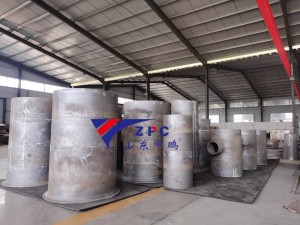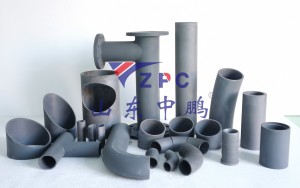Silicon carbide (SiC) is a material of choice in a variety of industrial applications due to its outstanding hardness, thermal stability, and chemical resistance. Among its many forms, silicon carbide tubes are particularly valued for their durability and performance in harsh environments. This article will delve into the complex process of manufacturing silicon carbide tubes, focusing on the production of reaction-sintered silicon carbide ceramic tubes.
Understanding Silicon Carbide
Before we delve into the manufacturing process, it’s important to understand what silicon carbide is. Silicon carbide is a compound of silicon and carbon that is known for its exceptional properties. It is a semiconductor that is resistant to high temperatures, oxidation, and corrosion. These properties make silicon carbide tubes ideal for applications in industries such as aerospace, automotive, and chemical processing.
Raw materials preparation
The first step in manufacturing silicon carbide tubes is to prepare the raw materials. High-quality silicon powder and carbon powder are prerequisites for producing high-performance reaction-sintered silicon carbide (RBSC). The purity of these powders is critical; any impurities will seriously affect the quality of the final product. In addition, the particle size distribution of the powders must be carefully controlled. A uniform particle size ensures that the material reacts evenly during the sintering process, resulting in a denser, stronger final product.
Ingredients and Mixing
Once the raw materials are prepared, the next step is batching and mixing. This process involves precisely controlling the ratio of silicon powder to carbon powder. The correct ratio is critical because it determines the chemical reactions that will occur during sintering. Thoroughly mixing the powders to ensure even distribution is essential to achieve consistent silicon carbide formation. This step is critical; any inconsistency in the mixture can result in defects in the final silicon carbide tube.
Forming the pipe shape
Once the batching and mixing process is complete, the next step is to shape the pipe. This can be achieved through a variety of methods, including cold isostatic pressing (CIP) or extrusion. CIP involves applying uniform pressure to the mixed powder in a die, resulting in a compact and well-formed shape. Alternatively, extrusion allows for continuous shaping of the material, which is particularly useful for producing longer pipes. The choice of shaping method depends on the desired size and specifications of the final product.
Sintering process
The sintering process is where the magic happens. The formed silicon carbide tube is placed in a high-temperature furnace with strictly controlled heating speed and holding time. During this stage, the silicon powder and carbon powder react chemically to form a dense silicon carbide structure. The sintering temperature is usually between 1400°C and 2000°C, depending on the specific formulation and desired properties of the final product. This step is crucial because it determines the mechanical strength and thermal stability of the silicon carbide tube.
Post-processing technology
After the sintering process is complete, the silicon carbide tube undergoes post-processing. This stage includes machining and surface polishing to meet precise dimensional and surface quality requirements. Machining may involve cutting, grinding or drilling to achieve the required dimensions, while surface polishing enhances the aesthetics and functional performance of the tube. Post-processing is critical to ensure that the final product meets industry standards and customer specifications.
Quality Control Measures
Throughout the production process, we implement quality control measures to ensure that the silicon carbide tubes meet the required standards. This includes testing the purity of the raw materials, monitoring the consistency of the mixing process, and inspecting during and after sintering. Advanced techniques such as X-ray diffraction and scanning electron microscopy can be used to analyze the microstructure of the silicon carbide to ensure that it meets the necessary performance standards.
Application of Silicon Carbide Tube
Silicon carbide tubes are used in a wide range of applications due to their excellent properties. In the chemical processing industry, they are used to convey corrosive fluids, while in the aerospace sector, they are used as components in high-temperature environments. In addition, silicon carbide tubes are increasingly used in energy applications, such as nuclear reactors and gas turbines, where their ability to withstand extreme conditions is invaluable.
In summary
The production of silicon carbide tubes is a complex and delicate process that requires careful attention to detail at every stage. From the preparation of high-quality raw materials to the precise control of the sintering process, each step plays a vital role in the quality and performance of the final product. As industries continue to seek materials that can withstand harsh conditions, the demand for silicon carbide tubes is likely to grow, making it even more important to understand their production process. Whether used for industrial applications or advanced technological uses, silicon carbide tubes represent a major advancement in materials science, providing durability and reliability in a variety of environments.
Post time: Mar-26-2025

